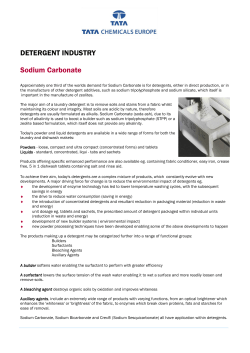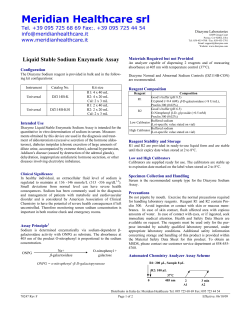
Determination of Sodium and Potassium Content Present in Water Sample
JPSBR: Volume 3, Issue 3: May June 2013 (105-107) ISSN NO. 2271-3681 Determination of Sodium and Potassium Content Present in Water Sample Collected from Girna and Godavari River by Flamephotometry * Amrutkar R. D. , Thube A.E., Kulkarni S. C., Mahatma Gandhi Vidyamanidr’s Samajshree Prashantdada Hiray College of Pharmacy, Loknete Vyankatrao Hiray Marg, Malegaon Camp, Malegaon-423105, (Nashik), Maharashtra, India. ABSTRACT: Flame photometry (more accurately called flame atomic emission spectrometry) is a branch of atomic spectroscopy in which the species examined in the spectrometer are in the form of atoms. Flame photometry is suitable for qualitative and quantitative determination of several cations, especially for metals that are easily excited to higher energy levels at a relatively low flame temperature (mainly Na, K, Rb, Cs, Ca, Ba, Cu). The major cation of the extracellular fluid is sodium and intracellular cation found to be potassium. When the concentration level of the sodium cation in the human plasma decreases leads to cause + Hyponatraemia and hypernatraemia when the level is raised. In case of potassium cation hypokalaemia (lowered plasma [K ]), + + hyperkalaemia (increased plasma [K ]) and hyperkaluria (increased urinary excretion of K ) The present article include the Comparative studies on Sodium and Potassium content Present in Water Sample Collected from Girna in Malegaon and Godavari ( Nasik) River. Key Words: Flame photometry, Sodium, Potassium. INTRODUCTION: Article history: Received: 06 Jan 2012 Revised: 22 Jan, 2012 Accepted: 20 June 2013 Available online 13 July 2013 For Correspondence: Mr. Rakesh D. Amrutkar Mahatma Gandhi Vidyamanidr’s Samajshree Prashantdada Hiray College of Pharmacy, Loknete Vyankatrao Hiray Marg, Malegaon Camp, Malegaon-423105, (Nashik), Maharashtra, India. Email: rakesh_2504@yahoo.co.in (www.jpsbr.org) Amrutkar R. D. et al Flame photometry (more accurately called flame atomic emission spectrometry) is a branch of atomic spectroscopy in which the species examined in the spectrometer are in the form of atoms. The other two branches of atomic spectroscopy are atomic absorption spectrophotometry and inductively coupled plasma-atomic emission spectrometry (ICP-AES, a relatively new and very expensive technique not used in Standard base experiments). In all cases the atoms under investigation are excited by light. Absorption techniques measure the absorbance of light due to the electrons going to a higher energy level. Emission techniques measure the intensity of light that is emitted as electrons return to the lower energy levels. Flame photometry is suitable for qualitative and quantitative determination of several cations, especially for metals that are easily excited to higher energy levels at a relatively low flame temperature (mainly Na, K, Rb, Cs, Ca, Ba, Cu).This technique uses a flame that evaporates the solvent and also sublimates and atomizes the metal and then excites a valence electron to an upper energy state. Light is emitted at characteristic wavelengths for each metal as the electron returns to the ground state that makes qualitative determination possible. Flame photometers use optical filters to monitor for the selected emission 105 JPSBR: Volume 3, Issue 3: May June 2013 (105-107) wavelength produced by the analyte species. Comparison of emission intensities of unknowns to either that of standard solutions (plotting calibration curve), or to those of an internal standard (standard addition method), allows quantitative analysis of the analyst metal in the sample solution. Flame photometry is based on measurement of intensity of light emitted when metal is introduced into a flame. A photoelectric flame photometer is a device used in inorganic chemical analysis to determine the concentration of certain metal ions, among them sodium, potassium, lithium, and calcium. The wavelengths of the colour tell us what the element is and the color intensity tells us how much element is present. Flame photometry is also named as flame emission spectroscopy because of use of flame to provide the energy of excitation to atoms introduced into the flame. In principle, it is a controlled flame test with the intensity of the flame colour quantified by photoelectric circuitry. The sample is introduced to the flame at a constant rate. Filters select which colours the photometer detects and exclude the influence of other ions. Before use, the device requires calibration with a series of standard solutions of the ion to be tested. The spectrophotometric technique as proven to be one of the most reliable and used techniques for the determination of concentration of Sodium, Potassium, Calcium and Magnesium. MATERIAL AND METHODS: Material: Sodium Chloride, Potassium Chloride, Distilled water, Water sample collected from Girna and Godavari River. Instrument: Figure 1 Flame photometer (Make-Elico-Model-CL220) Apparatus: Volumetric flasks, beaker, Glass rod, Magnetic stirrer. Preparation of standard solution: An analytical reagent quality sodium chloride (NaCl) is weigh Amrutkar R. D. et al ISSN NO. 2271-3681 and transfers it into 1 liter volumetric flask through a funnel. Simultaneously weigh 1.909 gm of analytical reagent quality of potassium chloride (KCl) and transfer it into the same volumetric flask through the same funnel. Add double distilled water to the flask, dissolved the crystals and make up the solution to the mark with double distilled water. The stock standard solution contains 1000 ppm/1000 ppm of sodium and potassium. From this stock standard solution 100, 80, 60, 40, 20 ppm solution of lower concentration was prepared. Aspirate Distilled Water and set the read out 00 by adjusting the zero control. Aspirate the standard solution that has higher concentration adjust the nobe to 100. For optimum performance the instrument should be allow 15 min to warm up during this warm up period a blank demonized water sample should be aspirated. Emissions were noted for all standard solution. Lastly water sample solutions were aspirated and emission was noted. PROCEDURE: Operating instruction: 1. 2. Switch the instrument on. Open the lid of filter chamber. Insert appropriate filter for the test opening and close the lids. 3. Insert the free end of the PVC take up capillary in distill water or the reagent. Adjust set zero controls to obtain 00 display on read out. 4. Insert the free end of the PVC take up capillary in the Na/Ca and K/Li working solution of highest concentration of the element to be determined. 5. Set the coarse selector of the each channel to low, medium or high range as depending on the working standard of highest concentration. Calibration in each channel. 6. Adjust the control of each channel to obtain a display exactly 100 on the read out of the channel. 7. Repeat operation of steps 3 and 6 to ensure 00 and 100 are display respectively when the blank and the working standard solution of highest concentration are aspirated into the flame. 8. Insert the free end of the PVC take up capillary in distilled water for a minute or two to wash the mixing chamber thoroughly before the actual test. 9. Insert the free end of the PVC take up capillary in the sample read the value of the concentration as displayed in the read out. 10. Feed the working standard solution of known concentration from time to time in a series of test to check the calibration. Check the 00 with the blank solutions. beakers, Glass rod etc. 106 JPSBR: Volume 3, Issue 3: May June 2013 (105-107) ISSN NO. 2271-3681 RESULT AND DISCUSSION: Potassium content Emission + For K 23 41 20 40 3 4 60 80 62 83 63 83 5 6 100 Unknown-I ( Girna river) 100 26 100 02 7 Unknown-II (Godavari river) 54 11 The development of flamephotometric method for the determination of unknown concentration of ions present in pharmaceuticals has been increases considerable in recent years because of their importance in pharmaceutical analysis. The concentration of sodium and potassium present in water sample collected from river was compare against standard solution (concentration in ppm) of sodium and potassium. Table 1 Graph was plotted on Y axis (Intensity of emission) verses X-axis (concentration in ppm).(Figure 1 and 2) The concentration of sodium and potassium ions present in Girna and Godavari river is 26 ppm and 2 ppm and 54 ppm and 11 ppm respectively. Concentration of sodium present in the water sample is more than potassium. 100 10 0 un kn ow nI un kn ow nII 80 0 80 60 20 60 40 40 40 20 Concentration in ppm 20 unknown-I unknown-II REFERENCES: 1. 2. 3. 5. 6. unknown-II Figure 2 Comparative Graph of Sodium content in standard 100 for unknown we take unknown sample collected from the river. Therefore it could be an experiment recommended in the routine pharmaceutical analysis practical for undergraduate student. unknown-I Intensity of Emission 80 solution and water sample 100 60 60 Figure 3 Comparative Graph of Potassium content in standard 120 80 40 Intensity of Emission 4. Sodium Content 20 10 0 un kn ow nI un kn ow nII 1 2 Emission + For Na 22 38 80 Concentration in ppm 120 100 80 60 40 20 0 20 Sr. No. Concentration in ppm Table: 1 Emission for Na and K with respective concentration and unknown sample 60 + 40 + 7. Chatwal, G. and Anand, S., Instrumentals methods by chemical analysis, Himalaya, publishing house Bombay, 1995, 2.367-3.388. th Remington, the science and practice of pharmacy, 20 edition. Volume-I by Lippincott Williams and Wilkins. 632. D. A. Skoog - D. M. West - F. J. Holler: Fudamentals of Analytical Chemistry (Saunders College Publishing, Fort Worth, US 1992.) Indian Pharmacopoeia 1996, government of Indian ministry of health and family welfare, volume-I, Published by controller of Publication, Delhi Pg.no.-A-72. A. H. Beckett, J. B. Stenlake, Practical Pharmaceutical Chemistry, Part-2, Published by CBS Publishers and th distributors 4 edition, Pg. no-258 Flame Photometric Analysis of Sodium and Potassium in Nanogram Samples of Mammalian Nervous Tissue Journal of Neurochemistry, 1968; 15 (7)547–562. Worth H.G., A comparison of the measurement of sodium and potassium by flame photometry and ion-selective electrode". Ann. Clin. Biochem. 1985; 22, 343-50. solution and water sample CONCLUSION: The obtained statistical information for determination of Concentration of sodium and potassium ions in water sample collected from rivers by flamephotometric method conclude that Concentration of sodium present in the river water sample is more than potassium. This method is simple and accurate therefore Instead of taking the marketed formulation for unknown we take unknown sample collected from the Amrutkar R. D. et al 107
© Copyright 2025















